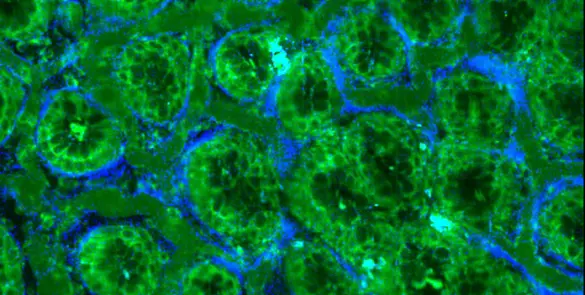Start
29/11/2020
End
31/05/2024
Status
Completed
CRIMSON
Website's ProjectStart
29/11/2020
End
31/05/2024
Status
Completed
CRIMSON
Website's Project
Coherent Raman Imaging for the Molecular Study of the Origin of Diseases
CRIMSON aimed to provide a next-generation bio-photonics imaging device based on vibrational spectroscopy, with the potential to revolutionize the study of the cellular origin of diseases allowing for novel approaches towards personalized therapy.
We emploied label-free broadband coherent Raman scattering (CRS) extended to the fingerprint region, in combination with artificial-intelligence spectroscopic data analysis, for fast cell/tissue classification with unprecedented biochemical sensitivity. We developed a hyperspectral CRS microscope for 3D quantitative imaging of sub-cellular compartments in living cells and organoids. We simulated future in-vivo studies and demonstrated the capability to image inside the body, realizing an innovative CRS endoscope and applying it to ex-vivo thick tissue slides.
To validate the CRS platform, we investigated three open biological questions related to cancer, as typical examples of the complexity and heterogeneity of cellular diseases. The results have profound societal impacts, improving patients’ quality of life and reducing public healthcare costs. CRIMSON relied on the development of new compact ultrafast lasers, innovative broadband CRS detection schemes and advanced spectral analysis routines.
CRIMSON brings together a multidisciplinary team of world-leading academic organizations, biomedical end users and innovative SMEs, with vertical integration of all required skills. CRIMSON bridges the gap between research and product development, increasing the Technology Readiness Level (TRL) and making CRS a user-friendly, robust and cost-effective mainstream tool for a vast biological research community. Commercial exploitation by the participating SMEs, including a biomedical equipment manufacturer, will create a competitive advantage in the European biophotonics-related market for microscopes and R&D tools.
The main goal of the CRIMSON project was to develop an innovative bio-photonic system for cell/tissue imaging which will be used as a research tool to understand the cellular origin of diseases. Our imaging technique was roadband coherent Raman scattering (CRS) extended to the fingerprint region, which is crucial for chemical identification. Broadband CRS combines the following advantages:
- Label-free imaging, avoiding the use of exogenous or endogenous labels.
- Living cell imaging capability.
- High acquisition speed, enabling the observation of dynamic cellular processes by time-lapse imaging.
- High biochemical sensitivity, thanks to the capability to acquire quantitative hyperspectral images allowing the identification of molecules by their unique vibrational spectrum.
- The possibility to couple these advantages with endoscopy-based in vivo imaging.
Despite its promise as a disruptive cell/tissue imaging method, CRS microscopy is currently not used by biologists as a standard research tool and remains confined to low Technology Readiness Level (TRL) laboratory applications. This is due to several limitations of current implementations of CRS:
- The laser source required for CRS is complex, expensive and needs regular alignment or maintenance, making it not suitable for biomedical research laboratories.
- CRS typically measures the signal at a few selected vibrational frequencies and does not provide the rich chemical information contained in spontaneous Raman, which measures the full vibrational spectrum.Most CRS systems work in the CH stretching region (2800-3100 cm-1), which gives stronger signals but delivers less spectroscopic information with respect to the fingerprint region (700-1800 cm-1), which has exquisite sensitivity to the chemical structure.
CRIMSON aimed at overcoming these limitations, by enhancing the information content of CRS microscopy and bringing it out of the research labs, making it accessible to mainstream biomedical researchers. Specifically, CRIMSON aimed at:
- Developing a compact, alignment-free and low-cost laser system for CRS based on fibre laser technology, thanks to our partner Active Fiber Systems GmbH.
- Extending CRS microscopy from single-frequency to broadband operation.Extending detection of CRS signal to the fingerprint region, which provides higher information content.
- Configuring the microscope system including all the requirements for time-lapse live cell imaging.
- Developing a CRS flexible endoscope imaging probe compatible with in vivo semi-invasive imaging, thanks to our partner LIGHTCORE TECHNOLOGIES.
- Using the extremely rich Raman spectral information in each point of the image (hyper-spectral data cube) by artificial intelligence (AI) based methods, e.g. chemometrics, machine learning and deep learning, to perform quantitative imaging with an unprecedented level of specificity and sensitivity for the study of intra- and inter-cellular processes, thanks to our partner 3rd Place.
- Combining these technological advances into a complete broadband CRS microscope for commercial exploitation, coupled to a flexible CRS endoscope for future in vivo imaging, thanks to our partner CRIL.
The CRS microscope/endoscope developed in CRIMSON offers a significant gain in the understanding of inter- and/or intra-cellular processes and it strengthens Europe’s industrial position in the biophotonics-related market for microscopes and research and development tools.
Research labs
VIBRA
Find out more